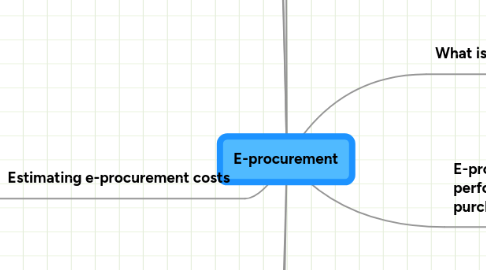
1. Types of procurement
1.1. There are two broad categories of procurement, those that related to manufacturing of products (production-related procurement) and operating or non-production-related procurement that supports the operations of the whole business
1.1.1. Participants in different types of e-procurement
1.1.1.1. Traditional manufacturers
1.1.1.2. Direct sales manufacturers
1.1.1.3. Value-added procurement partners
1.1.1.4. Online hubs
1.1.1.5. Knowledge
1.1.1.6. Online information services
1.1.1.7. Online retailers
1.1.1.8. Portal communities
1.1.2. Different types or applications of e-procurement
1.1.2.1. E-sourcing
1.1.2.2. E-tendering
1.1.2.3. E-informing
1.1.2.4. E-reverse auctions
1.1.2.5. E-MRO and web-based ERP
2. Drivers of e-procurement
2.1. Five key drivers or supplier selection criteria for e-procurement adoption related to improving
2.1.1. Control
2.1.1.1. improving compliance, achieving centralization, raising standards, optimizing sourcing strategy and improved auditing of data. Enhanced budgetary control is achieved through rules to limit spending and improved reporting facilities
2.1.2. Cost
2.1.2.1. improved buying leverage through increased supplier competition, monitoring savings targets and transactional cost reduction
2.1.3. Process
2.1.3.1. rationalization and standardization of e-procurement processes giving reduced cycle time, improved visibility of processes for management and efficient invoice settlement
2.1.4. Individual performance
2.1.4.1. knowledge sharing, value-added productivity and productivity improvements
2.1.5. Supplier management
2.1.5.1. reduced supplier numbers, supplier management and selection and integration
2.2. Some of the main dimensions of value highlighted by the approached
2.2.1. Examples of the benefits of e-procurement
2.2.1.1. Planning
2.2.1.1.1. this shows the potential for an e-procurement system to increase the quality and dissemination of management information about e-procurement
2.2.1.2. Development
2.2.1.2.1. e-procurement systems can potentially be incorporated early in new product development to identify manufacturing costs, this can help accelerate development
2.2.1.3. Inbound
2.2.1.3.1. this is main focus of e-procurement with efficiency gains from paperless transactions and more cost-effective sourcing possible through hubs or marketplaces
2.2.1.4. Production
2.2.1.4.1. the integration of systems managing
2.2.1.5. Outbound
2.2.1.5.1. this is management of fulfillment of products to customers
3. Estimating e-procurement costs
3.1. The impact of cost savings on profitability
3.1.1. The largest savings and impact on profitability will typically be for manufacturing companies in which procurement is a major cost element and there are many requisition for relatively low value items
4. Barriers and risks of e-procurement adoption
4.1. These barriers are specific to e-procurement. There are also more general limitations to e-business adoption mentioned such as the cost of implementation and managing change
4.1.1. Competition issues
4.1.1.1. e.g. in exchanges using collaborative purchasing
4.1.2. Possible negative perception from suppliers
4.1.2.1. e.g. their margins reduced further from e-auctions
4.1.3. Negotiated procurement benefits
4.1.3.1. e.g. may be shared with other exchange users who may be competitors
4.1.4. Creation of catalogues
4.1.4.1. e.g. can be a long process and costly to suppliers
4.1.5. Culture profile within organizations
4.1.5.1. e.g. resistance to change
4.2. Implementing e-procurement
4.2.1. Implementing e-procurement has the challenges of change management associated with any information system. If the implementation can mirror existing practices, then it will be most straightforward but many of the benefits will not be gained and the use of new technology often forces new processes to be considered
4.3. The different type of systems
4.3.1. Stock control system
4.3.1.1. this relates mainly to production-related procurement, the system highlights that reordering is required when the number in stocks falls below reorder thresholds
4.3.2. CD or wed-based catalogue
4.3.2.1. paper catalogues have been replaced by electronic forms that make it quicker to find suppliers
4.3.3. E-mail- or database-based workflow system
4.3.3.1. integrate the entry of the order by the originator, approval by manager and placement by buyer
4.3.4. Order-entry on website
4.3.4.1. the buyer often has the opportunity to order directly on the supplier’s website, but this will involve rekeying and there is no integration with systems for requisitioning or accounting
4.3.5. Accounting system
4.3.5.1. networked accounting systems enable staff in the buying department to enter an order which can then be used by accounting staff to make payment when the invoice arrives
4.3.6. Integrated e-procurement or ERP system
4.3.6.1. these aim to integrate all the facilities above and will also include integration with suppliers’ systems
4.4. Integrating company systems with supplier systems
4.4.1. Procurement model
4.4.1.1. Sell side
4.4.1.1.1. e.g. many catalogue-based B2B suppliers such as www.rswww.com
4.4.1.2. Buy side
4.4.1.2.1. Private exchanges hosted by manufacturers and major suppliers to these manufacturers
4.4.1.3. Independent marketplace
4.4.1.3.1. e.g. www.ec21.com, www.eutilia.net
5. B2B marketplaces
5.1. B2B marketplaces were heralded as transforming B2B purchases; however , many have had difficulty in achieving sustainable business models
5.1.1. Government marketplaces exchanges
5.1.1.1. Electronic B2B marketplaces are variously known as ‘marketplaces, exchanges or hubs’. Virtual locations with facilities to enable trading between buyers and sellers.
5.1.2. Reasons for limited adoption of e-marketplaces
5.1.3. From neutral to private B2B exchanges
5.1.4. Type of marketplace
5.1.4.1. Manufacturing-input marketplaces tend to be vertical marketplace sets up for a particular industry such as steel, construction or chemicals, while operating resources tend to be horizontal marketplaces offering a range of product to differing industries
6. The future of e-procurement
6.1. In the future, some suggest that the task of searching for suppliers and product may be taken over by software agents which have defines rules or some degree of intelligence that replicates intelligence in humans
6.1.1. Software (intelligent) agents
6.1.1.1. Software programs that assist humans by automatically gathering information from the Internet or exchanging data with other agents based on parameters supplied by the user
